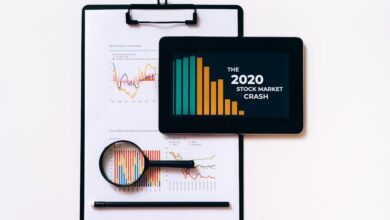Weathering the Economic Storm: Early Warning Signs, Investment Strategies, and Lessons from Recessions

In the ever-fluctuating landscape of the global economy, the specter of recession looms as a significant concern for businesses, investors, and consumers alike. Understanding the early warning signs of an economic downturn is crucial for navigating the challenges it presents. From shifts in consumer behavior to the ripple effects on global trade and supply chains, recessions can profoundly impact various sectors. This article delves into the early indicators of a recession, explores effective investing strategies during turbulent times, and examines the critical role of government stimulus in mitigating economic fallout. Additionally, we will reflect on lessons learned from past recessions and provide guidance for businesses seeking to prepare for and survive potential downturns. By equipping ourselves with knowledge and strategies, we can better navigate the complexities of economic cycles and emerge resilient in the face of adversity.
- 1. **Identifying the Signs: Early Indicators of an Economic Recession**
- 2. **Navigating the Storm: Investing Strategies for a Recessionary Environment**
1. **Identifying the Signs: Early Indicators of an Economic Recession**
Identifying the early signs of an economic recession is crucial for policymakers, businesses, and investors alike. Typically, several key indicators can signal that an economy is heading toward a downturn.
One of the most watched signals is the performance of the stock market. A consistent decline in stock prices, especially over a sustained period, can indicate waning investor confidence and expectations of lower corporate profits. Additionally, the yield curve, which plots interest rates of bonds of different maturities, often serves as a reliable predictor. An inverted yield curve, where short-term interest rates exceed long-term rates, has historically foreshadowed recessions.
Another important indicator is the unemployment rate. A noticeable increase in unemployment claims can suggest that businesses are starting to cut back on hiring or even laying off workers in anticipation of reduced consumer demand. Similarly, a decline in consumer spending, reflected in retail sales figures, can signal economic distress as households tighten their budgets in response to uncertainty.
Manufacturing activity is also a critical barometer; indicators such as the Purchasing Managers' Index (PMI) can reveal contractions in manufacturing output, which often precede broader economic slowdowns. Moreover, changes in consumer confidence surveys can provide insights into how optimistic or pessimistic consumers feel about the economy, influencing their spending behaviors.
Lastly, fluctuations in housing market indicators, such as home sales and building permits, can further illuminate potential economic troubles. A slowdown in these areas often reflects broader economic challenges, as housing is a significant driver of economic activity.
By closely monitoring these indicators, stakeholders can better prepare for potential recessions and mitigate their impacts.
Economic recessions are characterized by a significant decline in economic activity, often measured by a decrease in gross domestic product (GDP), increased unemployment rates, and reduced consumer spending. Understanding the early warning signs of a recession is crucial for businesses, investors, and policymakers. Common indicators include rising unemployment claims, declining consumer confidence, reduced manufacturing output, and a slowdown in housing markets. Monitoring these metrics can help stakeholders anticipate economic downturns and adjust their strategies accordingly.
Different sectors of the economy are impacted uniquely during recessions. Consumer discretionary sectors, such as retail and hospitality, often face the most significant declines as households cut back on spending. Conversely, essential services like healthcare and utilities tend to be more resilient. The financial sector may experience increased loan defaults and tighter credit conditions, while industries tied to commodities might face fluctuating prices based on global demand shifts.
Investing strategies during a recession typically focus on preserving capital and seeking opportunities in defensive sectors. Investors may favor stocks of companies with strong balance sheets, steady dividends, and consistent demand, such as those in healthcare, consumer staples, and utilities. Additionally, diversifying portfolios and considering alternative investments, such as bonds and real estate, can help mitigate risk.
Government stimulus plays a vital role in cushioning the effects of a recession. Measures such as direct financial assistance to individuals, tax relief for businesses, and increased public spending can stimulate demand and support economic recovery. Historical examples show that timely and targeted interventions can help stabilize economies and restore consumer confidence.
Consumer behavior often shifts during economic downturns, with individuals prioritizing essential goods and services over luxury items. This change can lead to a significant alteration in spending patterns, affecting businesses and industries reliant on discretionary spending. Moreover, consumers may adopt more frugal practices, seek out discounts, and become more mindful of their financial decisions.
The global trade landscape also experiences turbulence during recessions, as reduced consumer demand can lead to decreased imports and exports. Supply chains may face disruptions due to fluctuating demand, leading to inventory challenges and production delays. Businesses that rely on international trade must navigate these complexities and adapt to changing market conditions.
Lessons learned from past recessions, such as the Great Depression and the 2008 financial crisis, highlight the importance of preparedness and adaptability. Businesses that maintain strong financial reserves, diversify their revenue streams, and invest in technology are often better positioned to weather economic storms. Understanding historical patterns can provide valuable insights for navigating future challenges.
To prepare for and survive a recession, businesses should develop contingency plans, streamline operations, and focus on building customer loyalty. Proactive measures, such as enhancing digital capabilities and exploring new markets, can help companies remain agile and resilient in an uncertain economic environment. By recognizing the signs of a recession and implementing strategic responses, stakeholders can better navigate the complexities of economic downturns and emerge stronger on the other side.
2. **Navigating the Storm: Investing Strategies for a Recessionary Environment**
Investing during a recession requires a strategic approach to navigate the uncertainties and potential downturns in the market. As economic conditions become volatile, investors often seek to protect their capital while identifying opportunities for growth. Here are several effective strategies to consider:
1. **Defensive Stocks**: Investing in defensive stocks—companies that provide essential goods and services, such as utilities, healthcare, and consumer staples—can help mitigate risk. These sectors tend to be less sensitive to economic cycles, as demand for their products remains relatively stable during downturns.
2. **Dividend-Paying Stocks**: Companies with a strong history of paying dividends can offer a reliable income stream, even when stock prices are fluctuating. Dividend-paying stocks can provide a buffer against losses, as investors receive returns through dividends while waiting for potential price appreciation.
3. **Bonds and Fixed Income Investments**: During a recession, investors often flock to bonds, particularly government and high-quality corporate bonds, as they are generally considered safer than equities. Fixed-income investments can provide stability and consistent returns, making them an attractive option in uncertain economic times.
4. **Diversification**: A well-diversified portfolio can help reduce risk during a recession. By spreading investments across various asset classes, sectors, and geographic regions, investors can protect themselves from the adverse effects of a downturn in any single area.
5. **Value Investing**: Recessions can lead to undervaluation of quality companies. Value investing involves identifying stocks that are trading below their intrinsic value. Investors can capitalize on these opportunities by purchasing shares of fundamentally strong companies at discounted prices, positioning themselves for potential gains when the market recovers.
6. **Alternative Investments**: Diversifying into alternative assets, such as real estate, commodities, or hedge funds, can provide additional protection against market volatility. These investments often have low correlations with traditional stocks and bonds, serving as a hedge during economic downturns.
7. **Cash Reserves**: Maintaining a portion of the portfolio in cash or cash-equivalents allows investors to stay flexible and take advantage of opportunities that arise during market downturns. Having liquidity enables quick responses to market changes and the ability to invest in undervalued assets.
8. **Stay Informed and Adjust**: Regularly reviewing and adjusting investment strategies based on economic indicators and market conditions is crucial. Staying informed about macroeconomic trends, interest rates, and government policies can help investors make timely decisions.
By employing these strategies, investors can better navigate the challenges of a recessionary environment while positioning themselves for future growth and recovery.
In conclusion, understanding the early warning signs of an economic recession is crucial for individuals, businesses, and policymakers alike. By recognizing these indicators, stakeholders can take proactive measures to mitigate potential impacts. Recessions affect various sectors differently, necessitating tailored investment strategies that prioritize resilience and adaptability. Government stimulus plays a vital role in cushioning the economy, providing necessary support to households and businesses during downturns.
Moreover, shifts in consumer behavior highlight the need for businesses to remain agile and responsive to changing market dynamics. The implications of recessions extend beyond national borders, influencing global trade and supply chains, which underscores the interconnectedness of today’s economy.
Reflecting on lessons learned from past recessions can equip us with valuable insights to navigate future challenges more effectively. By implementing strategic planning and preparation, businesses can not only survive but potentially thrive during economic downturns. As we move forward, cultivating a deeper understanding of these elements will be essential for fostering resilience in both personal finance and broader economic systems.





